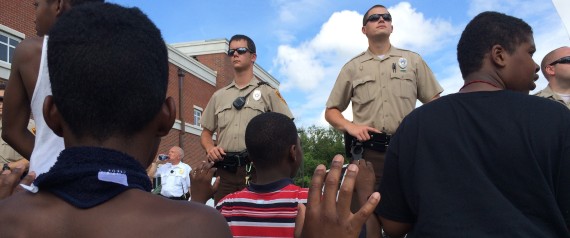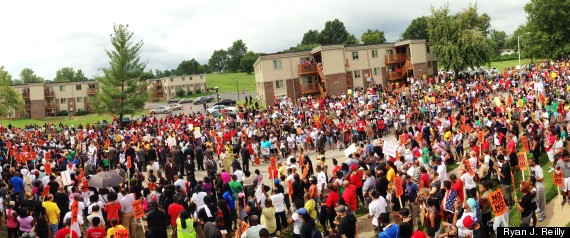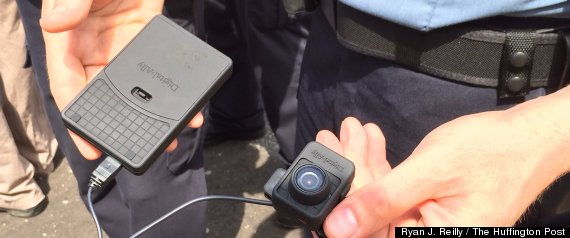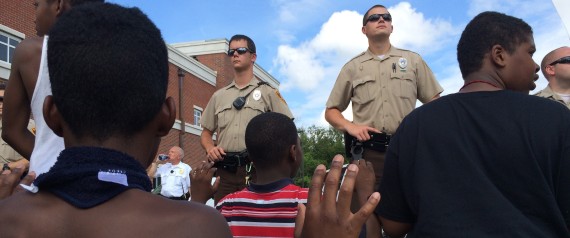
FERGUSON, Mo. — Hundreds of demonstrators tracked through pouring rain and blistering heat on Saturday, calling for accountability for the officer who gunned down an unarmed 18-year-old here three weeks ago and for broader policing reforms.
The death of Michael Brown and the aggressive police response to the demonstrations that followed have sparked a national conversation about race and law enforcement. Now that much of the national media has moved on — a point that was repeatedly made by speaker after speaker at a rally in a nearby park on Saturday — activists are working on channeling the anger exposed in the wake of Brown’s death into concrete changes to policing tactics in the St. Louis region.
Some of the most recognizable faces from the past three weeks of protests were out on the scene on Saturday, including Brown’s family members, Missouri state Sen. Maria Chappelle-Nadal, St. Louis Alderman Antonio French, Ferguson Democratic committeewoman Patricia Bynes and Edward Crawford, the 25-year-old captured in a now-iconic photo hurling a flaming tear gas canister back at police officers while wearing an American flag T-shirt.
Brown’s mother, Lesley McSpadden, wore a T-shirt bearing an image of her son that read, “A Bond Never Broken.” She was protected by suited-up members of the Nation of Islam as she and Brown’s father, Michael Brown Sr., made their way across town. Spread out across the route were tables stacked with shirts with slogans like “I survived the Ferguson riots” and “I am Mike Brown.” There were also booths where protesters could register to vote and petitions calling for the indictment of Darren Wilson, the Ferguson police officer who shot Brown dead on Aug. 9.

The crowd, which numbered over 1,000 people, made its way from the Canfield Green apartment complex, where Brown died, to West Florissant Avenue, the epicenter of the protests and the home of businesses that were looted. Then the protesters marched up Ferguson Avenue, in the direction of the police station. As rain poured down, they headed to Forestwood Park, where a massive tent and a stage on loan from the St. Louis County Parks Department were set up.
The crowd was mostly black, but it included plenty of white demonstrators as well. One of them was Michael Maresco, 50, a Ron Paul supporter from Richmond Heights, Missouri, who was carrying a massive rainbow Tea Party flag and said he was there to call for police accountability. Another was Janet Cuenca, a 76-year old retired teacher, who rode a motorized scooter and wore a shirt that read, “I can’t believe I’m still protesting this crap.”
Police officers kept a light touch as the demonstrators blocked streets, wearing only normal uniforms and driving regular police cars. Heavily-armored, military-style vehicles were nowhere to be seen, nor were officers in riot gear or canisters of tear gas.
“Should be a nice anti-me rally,” Ferguson Police Chief Tom Jackson told The Huffington Post. Indeed, speakers on the stage called on both Jackson and Ferguson Mayor James Knowles III to resign their positions.

Anthony Shahid, an older gentleman who has been out in the streets wearing chains during the protests and who marched next to Brown’s mother on Saturday, called on the crowd to stop their cars along the highway on Monday as an act of civil disobedience. He said people should stop at 4:30 p.m. for four and a half minutes, meant to represent the four and a half hours Brown’s body lay in the street after his death.
Silver Moore, an activist with the Detroit chapter of the group Black Lives Matter, said she came to get across a message. “We matter enough not to be gunned down by police,” she said. “We matter enough not to have our bodies left in the street for four hours.”
After several speeches by activists and community members, small groups of protesters broke away and headed to North Florissant Road, where they gathered in front of the police station. Eventually the rest of the demonstrators joined them, blocking off traffic in the street as officers formed a line in front of the station.
Some of the cops were from Ferguson, while others were from St. Louis County or the Missouri Highway Patrol. Nearly all of the Ferguson officers were wearing small, clip-on body cameras, donated by two companies in the wake of Brown’s death. Some, but not all, of the officers were wearing name plates.

A few hours later, the crowd had thinned out, but some of the more aggressive demonstrators remained. One man yelled an anti-gay slur at officers, and said that one of the cops “looked like a child molester.” He screamed “fuck you” at the officers over and over again.
Black police officers came under particular scrutiny from that small number of demonstrators, and attempts by others — including French — to calm them down were unsuccessful.
“Your son look like us, right? Your son look like us? Your son look just like us, you gotta feel us bro,” one man yelled at a black cop. A woman asked an officer if his “master” had let him come to the protest.
Even Highway Patrol Captain Ron Johnson, whose management of the police response to the demonstrations has drawn praise from the community, was at the receiving end of some harsh insults.
“He’s a sell-out!” said a man who repeatedly hurled an anti-black slur at Johnson and would only identify himself as “Mike Brown.” “Over here acting like you running these cops — you ain’t running shit!” he said. “The people make a move right now, what you gonna do? Call the white man. You can’t even say shoot! You gotta call the white man and ask, can you shoot?”

Johnson raised his phone at one point and appeared to take a photo of the man. Later, as the crowd continued to disperse, a few officers grabbed the man and took him into custody, quickly walking him behind the line of police officers and, presumably, into a Ferguson jail cell. Neither Johnson and nor any other officers would say why the man was being arrested.
At McDonald’s, on the other side of town, former St. Louis Rams cornerback Aeneas Williams sat at a table, chatting with several residents about what kind of change was needed in Ferguson and about what should happen to Wilson. On his way out the door, Williams stopped to chat with a man in a white T-shirt who was charging his phone.
“If he don’t go to jail,” the man said, “they gonna burn this city down.”















